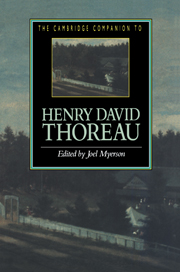Book contents
- Frontmatter
- 1 Thoreau’s reputation
- 2 Thoreau and Concord
- 3 Thoreau and Emerson
- 4 A Week on the Concord and Merrimack Rivers
- 5 Thoreau as poet
- 6 Thoreau and his audience
- 7 Walden
- 8 Thoreau in his Journal
- 9 The Maine Woods
- 10 A wild, rank place
- 11 Thoreau’s later natural history writings
- 12 Thoreau and the natural environment
- 13 Thoreau and reform
- Further reading
- Index
- Series List
6 - Thoreau and his audience
Published online by Cambridge University Press: 28 May 2006
- Frontmatter
- 1 Thoreau’s reputation
- 2 Thoreau and Concord
- 3 Thoreau and Emerson
- 4 A Week on the Concord and Merrimack Rivers
- 5 Thoreau as poet
- 6 Thoreau and his audience
- 7 Walden
- 8 Thoreau in his Journal
- 9 The Maine Woods
- 10 A wild, rank place
- 11 Thoreau’s later natural history writings
- 12 Thoreau and the natural environment
- 13 Thoreau and reform
- Further reading
- Index
- Series List
Summary
The question of who constitutes a writer’s audience is most usefully and fully understood if we begin with the premise that an audience is determined by the intersection of the literary marketplace with the writer’s own ambitions and self-definition as a writer. On the one hand, we want to consider the relationship from the author’s point of view: What kind of influence did Thoreau hope to have on his readers? Who did he hope or think would read his works or hear his lectures? How did he hope to attract and engage an audience, or, conversely, what expectations or demands did he make of his audience? On the other hand, we also want to consider the relationship from the point of view of the audience, or potential audience, for his works: What was the status of writers in American society of the time? What expectations and demands did the reading public make of authors writing in the particular genres Thoreau worked in, or through the particular media he employed (such as the monthly magazines, or the lyceum lecture system)? Moreover, we need to ask who could have constituted Thoreau’s audience? Who was literate? Who could afford to buy books and magazines? What constraints on the geographical distribution of print material defined Thoreau’s potential audience? Who had access to the lyceums?
- Type
- Chapter
- Information
- The Cambridge Companion to Henry David Thoreau , pp. 71 - 91Publisher: Cambridge University PressPrint publication year: 1995
- 2
- Cited by

